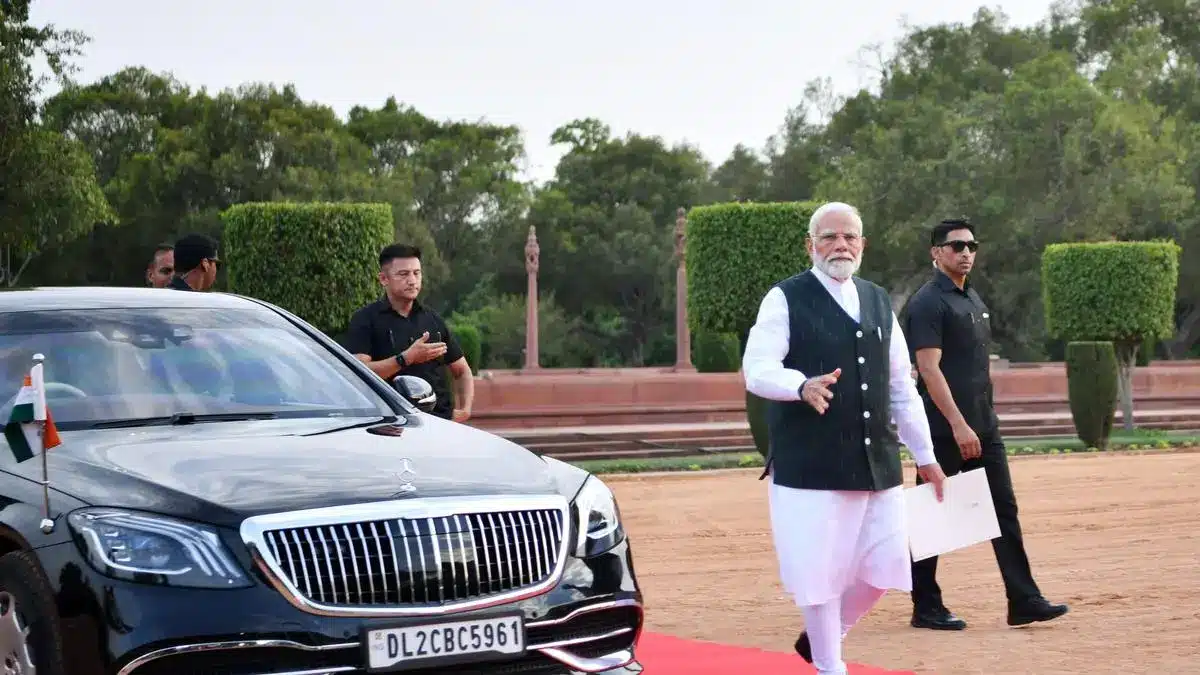What’s in today’s article?
- Why in the News?
- About Neighborhood First Policy
- Significance of the Policy
- Challenges Associated with the Policy
- Success / Major Initiatives
- Infrastructure Projects
- Bilateral Ties
Why in the News?
- As Prime Minister-elect Narendra Modi prepares to take oath for his third term, the focus is once again back on India’s foreign policy and how it will take shape over the next five years.
- The country’s Neighborhood First Policy determines its engagement with neighboring nations.
About Neighborhood First Policy
- India’s ‘Neighbourhood First policy’ guides its approach towards the management of relations with countries in its immediate neighbourhood, that is, Afghanistan, Bangladesh, Bhutan, Maldives, Myanmar, Nepal, Pakistan and SriLanka.
- Objective: To enhance physical, digital and people to people connectivity across the region, as well as augmenting trade and commerce.
- The policy prioritises improving physical, digital, and people-to-people connectivity within the region, while also boosting trade and commerce.
- Over time, the Neighborhood First Policy has become a key institutional focus across various government departments responsible for managing relations and policies with our neighbours.
- The policy officially came to being in 2008.
Significance of the Policy
- Countering Chinese influence: By collaborating closely with neighboring countries, India can counterbalance Chinese influence in the Indian Ocean region
- Support in multilateral forums: Working with neighboring partners strengthens India’s leadership role in representing the interests of the Global South at international forums. This fosters better understanding and cooperation on global issues.
- Ensuring territorial integrity: Collaboration with neighboring countries is essential for India to protect its territorial integrity and tackle separatist threats effectively.
- Increasing maritime security: Effective cooperation with neighbours is key to bolstering maritime security, which enables India to tackle transnational security challenges more effectively.
- Addressing energy security: Close cooperation with neighboring countries is critical for India’s energy security, particularly concerning the import of oil and gas through sea routes.
- Bridging development deficits: Actively engaging with neighboring countries helps in the development of India’s northeastern states, thus narrowing development disparities in the region.
- Leveraging soft power diplomacy: India’s deep cultural and historical connections with its neighbours strengthen people-to-people ties, solidifying India’s influence in the region through soft power diplomacy.
Challenges Associated with the Policy
- Geopolitical tensions: Issues like border disputes and political disagreements can complicate relationships.
- Implementation issues: Difficulties in executing cross-border projects due to logistical and bureaucratic challenges.
- Economic differences: Different levels of economic development among neighboring countries can affect the balance and effectiveness of cooperation.
Success / Major Initiatives
- SAARC (South Asian Association for Regional Cooperation):
- India has played a major role in SAARC, aimed at promoting regional cooperation.
- However, the effectiveness of SAARC has been limited due to political differences, particularly between India and Pakistan
- BIMSTEC (Bay of Bengal Initiative for Multi-Sectoral Technical and Economic Cooperation):
- BIMSTEC has gained prominence as an alternative to SAARC, focusing on economic cooperation, security, and cultural exchange among countries bordering the Bay of Bengal.
Infrastructure Projects
- BBIN Initiative (Bangladesh, Bhutan, India, Nepal): Improving Road and Rail connectivity.
- Kaladan Multi-Modal Transit Transport Project: Connecting India with Myanmar and further with Southeast Asia.
- Chabahar Port: Developing a strategic port in Iran to improve connectivity with Afghanistan and Central Asia.
Bilateral Ties
- Bangladesh:
- Export-import: $11,061 million-$1,845 million
- India and Bangladesh have deep historical ties rooted in India’s role in Bangladesh’s liberation.
- Today, they share a robust trade relationship, which amounted to $12,906 million in the 2023-24 financial year, with India exporting machinery and textile, while Bangladesh exports garments and fish.
- Sri Lanka:
- Export-import: $4,118 million-$1,424 million
- Ties between the people of India and Sri Lanka can be traced back to ancient times.
- In 2023-24, their bilateral trade was valued at $5,542 million, with significant Indian exports of petroleum and automobiles.
- Nepal:
- Export-import: $7,041 million-$830 million
- India and Nepal share an open-border relationship, reflecting their deep historical and cultural ties.
- In 2023-24, bilateral trade amounted to $7,871 million, dominated by Indian exports of petroleum products and machinery.
- Maldives:
- Export-import: $892 million-$87 million
- Over the years, India and the Maldives have maintained close ties. Most notably, India helped prevent a coup in Maldives in 1988.
- The Indian Armed Forces continued to have a modest presence in the archipelago, until President Muizzu came in on an “India Out” platform.
- Seychelles:
- Export-import: $76 million-$9 million
- India and Seychelles share a strategic relationship, particularly in maritime security and environmental cooperation.
- Located north of Madagascar, Seychelles is among the most strategically important archipelagos in the Indian Ocean.
- Bhutan:
- Export-import: $964 million- $339 million
- India and Bhutan are, what one can call, all weather friends with significant economic and cultural exchanges.
- In 2023-24, bilateral trade was $1.3 billion, with India being a major partner in Bhutan’s hydroelectric power sector.
- Mauritius:
- Export-import: $778 million-$74 million
- India and Mauritius enjoy close relations, underpinned by strong cultural and economic ties.
- Bilateral trade in 2023-24 was valued at $ 852 million, with key exports from Mauritius including textiles and sugar.
Q1. When was SAARC established?
The South Asian Association for Regional Cooperation (SAARC) was established on 8 December 1985. The Secretariat of the Association was set up in Kathmandu, Nepal, on 17 January 1987. SAARC has eight member countries (Afghanistan, Bangladesh, Bhutan, India, Maldives, Nepal, Pakistan and Sri-Lanka).
Q2. What is the status of BBIN?
Bangladesh, Nepal and India have ratified the BBIN Agreement, while ratification by Bhutan is pending.
Source: Narendra Modi swearing-in | ‘Neighbourhood First’ to be on show
Last updated on January, 2026
→ Check out the latest UPSC Syllabus 2026 here.
→ Join Vajiram & Ravi’s Interview Guidance Programme for expert help to crack your final UPSC stage.
→ UPSC Mains Result 2025 is now out.
→ UPSC Notification 2026 is scheduled to be released on January 14, 2026.
→ UPSC Calendar 2026 is released on 15th May, 2025.
→ UPSC Prelims 2026 will be conducted on 24th May, 2026 & UPSC Mains 2026 will be conducted on 21st August 2026.
→ The UPSC Selection Process is of 3 stages-Prelims, Mains and Interview.
→ UPSC Result 2024 is released with latest UPSC Marksheet 2024. Check Now!
→ UPSC Toppers List 2024 is released now. Shakti Dubey is UPSC AIR 1 2024 Topper.
→ Also check Best IAS Coaching in Delhi

















